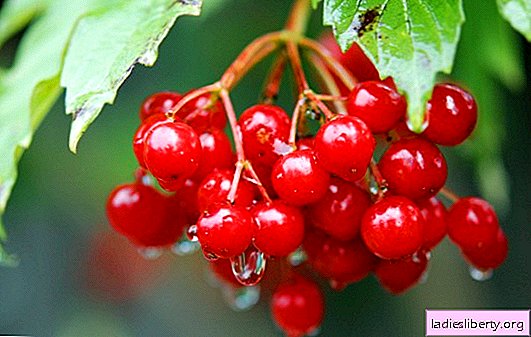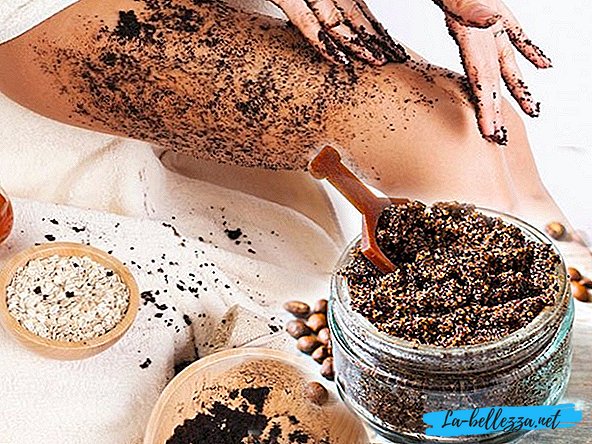
Among the ancient Slavs, viburnum red symbolized youth, beauty, health and love. She played the role of a wedding tree and her flowers decorated the outfit of the bride. The taste of the berry is bitterly sour, not for everybody, but there are a lot of recipes with its participation in cooking. Red viburnum is rich not only in symbolism and entering into recipes for various dishes, but also in a high content of nutrients, thanks to which it is in demand by traditional medicine and is included in the pharmacopeias of many countries.
Red viburnum: useful properties
The high value of the properties of viburnum is provided by the variety of active substances included in it, the therapeutic effect of which is enhanced by the addition and modification of each other. In various parts of the plant contains a whole bunch of organic complex compounds:
• ether-like tannins and resinous substances - contribute to the dissolution of clots and blood clots in the blood, thereby increasing its coagulability;
• flavonoids - promote enzyme activity, reduce brittleness and increase capillary elasticity;
• organic acids - participate in the metabolism, suppress the vital activity of pathogens and calm the nervous system;
• steroidal alcohols - act as regulators of many physiological processes of the body;
• vitamins - accelerate and enhance the action of other substances, provide the interaction of physiological and biochemical processes in the body.
• pectins - purify the blood of toxins and radioactive elements and contribute to better digestibility of food.
Viburnum red berries have beneficial properties not only in beauty and edibility. They improve the activity of the heart, contribute to the cure of diseases of the stomach and intestines. The diuretic and anti-inflammatory properties of the fruit help against colds and various skin disorders. Berry juice with honey is used for liver diseases and jaundice.
Liquid preparations from viburnum bark have an astringent and anti-inflammatory effect. They are used to enhance uterine tone, lower blood cholesterol, and as a hemostatic and sedative. Infusion of the bark improves performance, increases tone and has a calming effect.
The seeds of red viburnum have no less beneficial properties than the pulp of berries. Valerianic acid reduces CNS excitability and improves sleep. The fatty acids contained in the plant are involved in the regulation of renal circulation.
Red guelder-rose: benefits in the fight against diseases
For treatment, you can use both your own fees and drugs purchased at the pharmacy. While in folk medicine, bark, branches, inflorescences, berries and leaves are used, in official pharmaceuticals only bark, flowers and fruits of the plant are used.
Traditional medicine is able to defeat many diseases using means based on viburnum red. The benefits of natural medicines are that they have no side effects. Tinctures, decoctions and extracts of viburnum can successfully treat such diseases:
1. ARVI, tonsillitis, bronchitis. Viburnum preparations, due to their anti-inflammatory and diaphoretic effects, are successfully used in the treatment of colds, strengthen immunity and accelerate recovery.
2. Diseases of the stomach and intestines. Viburnum juice contributes to the production of bile, and a decoction of berries helps with gastritis and normalizes acid secretion in the stomach. Helps with ulcers and indigestion.
3. Problems with the heart and blood vessels. Guelder-rose red helps well with hypertension, angina pectoris and atherosclerosis, stabilizes the contraction of the heart muscle and strengthens the blood vessels.
4. Disorder of the nervous system. Berries and juice of viburnum soothe headaches, help with sleep disturbance and in the treatment of neurasthenia and epilepsy. With hysteria and convulsions, a decoction of the bark is used.
5. Skin diseases. A decoction of bark or berries gives good results in the treatment of furunculosis, psoriasis, eczema, dermatitis and contributes to the rapid healing of various wounds and abrasions.
6. Diseases of the liver, kidneys and urinary system. Hepatitis, jaundice, urethritis, cystitis and edema of renal origin are treated with tinctures, decoctions, extracts and juice of viburnum.
7. Internal bleeding and gynecological problems. As an anti-inflammatory and hemostatic agent, bark decoction and viburnum red extract are used with good and with good results for painful menstruation, in the postpartum period, with hemorrhoids and stomach ulcers.
Red viburnum: benefits in dietetics and cosmetology
Nutritionists also found in red viburnum useful for creating therapeutic dietary dishes.
Berries are low in calories and therefore they are used in diets for weight loss. People who are in a constant struggle with their own weight have a difficult time without a sweet and constant replenishment of vital elements. Losing weight is much "tastier" with low-calorie desserts that can be prepared from viburnum berries.
Kalina red has found application in cosmetology. To get rid of acne, you need to regularly wipe your face with a decoction of viburnum bark or berry juice. There are various recipes for making masks: for dry and oily skin, for smoothing wrinkles, for rejuvenating and whitening the skin, for swelling of the eyelids and circles under the eyes. From the berries of viburnum they even prepare a composition against cellulite.
Viburnum seeds of red benefit not only diet lovers. They contain a large number of biologically active substances, so the oil obtained from them is used as part of food additives, some drugs and cosmetics. The benefits of the oil are enhanced by the natural carotenoids with which it is rich. Their action as natural antioxidants protects the body from external harmful effects and slows down the aging process.
Red viburnum: contraindications and harm
Viburnum red, like a real cure, can be a cure for many diseases, but there are times when treatment can harm it. Any tool has limits of use. There are restrictions for viburnum red. Contraindications to the use of viburnum drugs exist for people with such health problems:
1. Increased blood coagulation. The hemostatic property of viburnum can cause blood clots in people with high blood viscosity.
2. Low blood pressure (hypotension). Viburnum preparations for hypotension can lead to loss of consciousness.
3. Pregnancy. The use of viburnum during pregnancy can provoke a violation of the fetus.
4. Gouty arthritis. The plant contains acids that affect the health of the joints is not the best way.
5. Increased acidity. Guelder-rose differs in the high content of organic acids and at its use the stomach ulcer can develop.
6. Overdose. The high content of vitamin C in viburnum is a plus, but excessive passion for berries can cause an allergic reaction and lead to acne, so it is recommended not to give them to children under 2 years old.
Viburnum red has few contraindications, but it is better to consult a specialist regarding the regimen and dosage of taking medications. Treatment requires an individual approach, and you need to start with a diagnosis and follow the prescriptions and advice of your doctor.











